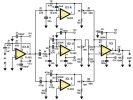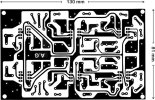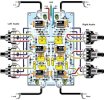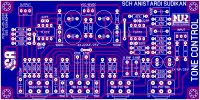If you have an audio preamplifier whose "tone control" does not fully satisfy you, you may replace the existing stage with this stylish 3-way stereo tone control circuit which can act not only on treble and bass, but also on mid tones. The circuit is able to cut or boost bass, mid, and treble as much as ±20 db.
The 3-way tone control circuit, is basically a real miniature equalizer which uses just three filters:
- A low-pass filter with a cutoff frequency of about 300 Hz for the low frequencies
- A bandpass filter, centered between 300 and 3000 Hz for the middle frequencies
- A high-pass filter with a cutoff frequency of about 3,000 Hz for the high frequencies.
The circuit is a stereo equalizer, so, it has separate tone controls for the Right R) and the Left (L) audio channel, respectively. Each audio channel uses five (5) FET input type operational amplifiers. Those are the TL081 and TL082, that exhibit excellent quality.
The electronic circuit
The electronic circuit of the Stereo Tone Control is presented on figure 1. Since the Right (R) and the Left (L) audio channels are the same, only one audio channel is shown on figure 1. In a stereo circuit, it is essential to use perfectly identical components in both audio channels; otherwise the 2 audio channels will have different audio responses.

Figure 1. The electronic schematic of the Stereo Tone Control
Note: The only difference between the two channels of this tone control circuit is on the use of the amplifiers that are present within the integrated circuits. TL082 is a dual op-amp, so, it contains two identical op-amps; op-amp A and B, respectively. For the A- amplifier, pins 2 and 3 are the inputs, and pin-3 is the output. As for the B-amplifier, pins 5 and 6 are the inputs, and pin 7 is the output. For the Right audio channel, pin numbering on the PCB is exactly the same as in the circuit diagram, i.e. IC1 / B is actually the input stage, IC1 / A is the low-pass filter, IC2 / A is the bandpass filter and IC2 / B is the high-pass filter. In contrary, for the Left audio channel, op-amps are used on a reverse manner: IC1 / B is not used as the input stage, but as the low-pass filter, IC1 / A serves as the input stage, IC2 / A is the high-pass filter, and IC2 / B is the band-pass for mid-tone.
These differences are not essential for the assembly, since the only thing you’ll have to do carefully is to just place all components on the PCB by following the assembly instructions. However, these differences are essential for someone who will try to check the circuit by using an oscilloscope.
Returning to our electrical diagram, we note that the input signal is applied, via the capacitor C1 and the resistor R1, to the inverting input (pin 6) of the differential amplifier IC1 / B, which is used exclusively as an input buffer with unity gain. In fact, on its output (pin 7), the audio signal will have exactly the same amplitude with that of the input signal. Then, the signal is applied on the three filters; low-pass, band-pass and high-pass, based on IC1 / A, IC2 / A, and IC2 / B, respectively . All filters are of unitary gain, and each one of them isolates a specific frequency band.
In practice, the output from IC1 / A will contain all the signal components that have frequencies below 300 Hz. The output from IC2 / A will contain all frequencies between 300 and 3000 Hz and the output from IC2 / B will contain frequencies that are higher than 3000 Hz.

Figure 2. The Printed Circuit Board of the Stereo Tone Control
Each filter has unity gain and its output is grounded through a logarithmic potentiometer (see R6, R12, R18). Each potentiometer acts as an adjustable attenuator. We have chose the values of R7, R13 and R19, in such a way that by turning a potentiometer towards its maximum, the signal taken from its wiper does not undergo any attenuation, but while rotating it towards its minimum, the signal undergoes an attenuation of about 40 dB.
Both signals from the low-pass filter and the high pass filter are then applied via resistors R8 and R20, respectively, to the inverting input (pin 2) of IC3 (TL081). The output signal from the band-pass filter, is applied to the non-inverting input (pin 3) of IC3 through a voltage divider consisting of R14 and R15. IC3 is used as a summing amplifier and mixes the signals coming from the three filters. It also provides some amplification of about 20 dB, therefore if a potentiometer is rotated toward its maximum, knowing that in this condition the signal of the corresponding filter has the same amplitude with its input, it is obvious that at the output of the tone control the corresponding signal will be amplified by about 20 dB. If the potentiometer is rotated to its idle position, and in this case the attenuation introduced by the filter will be equal to about 20 dB, that attenuation will be completely compensated by the gain of the summing amplifier (which is also equal to 20 dB), and the output signal will have the same amplitude which had at the input.
Finally, if a potentiometer is rotated towards its minimum, the filter attenuation will be about 40 dB, and the gain of the mixer (that is, 20 dB) will fail to completely compensate the attenuation for the corresponding filter, and the output signal for the corresponding frequency band will be attenuated to about 20 dB (in fact 40-20 = 20 dB.
To complete the description of the electronic circuit, we must say that TL082 is a dual operational amplifier, and is perfectly equivalent to uA772, TL072 and LF353 (that are dual op-amps, too) . TL081 contains only a single operational amplifier, and it matches TL071 and LF351.
The whole circuit needs to be supplied from a dual voltage of ±15 volt. Current consumption is about 50mA. The input can be as high as 2 V p/p. A much stronger signal will cause significant distortion. The signal amplitude at the output, may be as much high as 20Vp/p.
How to build the Stereo Tone Control circuit
The circuit can be built on the printed circuit board of figure 2. This is a single-sided board, especially designed to accommodate the Stereo Tone Control circuit. Anyone who wishes to build a “mono” tone control, may use the same PCB, and mount on it only half of the components (those that only need for one audio channel).
All resistors used in this project are of 1/4watt type, and they have a tolerance of 5%. Capacitors must also be of low tolerance. Use electrolytics, only if necessary and remember to place them on the PCB with respect to their correct polarity.
Please note that the PCB has two jumpers (see Figure 3). One jumper is in the lower right corner, next to IC1, and the other one is in the center, next to IC2. Both jumpers are made from a copper wire. Placing the components on the PCB and building the circuit is easy enough, if you follow to the instructions given by the assembly guide of figure 3.

Figure 3. Assembly instructions for the Stereo Tone Control
We also recommend to you, to use shielded cables for inputs and outputs, as well for the connections of the 6 potentiometers, otherwise the circuit may pick up electromagnetic noise from nearby circuits. For the potentiometers, you may use sliding ones than rotary ones indicated here.
It is better to use sockets for the ICs, and not to solder them directly on the PCB. Ideally, the circuit may be placed inside a grounded metal box, to be completely shielded, and the cases of the potentiometers may be also grounded to the metal box.
The 3-way tone control circuit, is basically a real miniature equalizer which uses just three filters:
- A low-pass filter with a cutoff frequency of about 300 Hz for the low frequencies
- A bandpass filter, centered between 300 and 3000 Hz for the middle frequencies
- A high-pass filter with a cutoff frequency of about 3,000 Hz for the high frequencies.
The circuit is a stereo equalizer, so, it has separate tone controls for the Right R) and the Left (L) audio channel, respectively. Each audio channel uses five (5) FET input type operational amplifiers. Those are the TL081 and TL082, that exhibit excellent quality.
The electronic circuit
The electronic circuit of the Stereo Tone Control is presented on figure 1. Since the Right (R) and the Left (L) audio channels are the same, only one audio channel is shown on figure 1. In a stereo circuit, it is essential to use perfectly identical components in both audio channels; otherwise the 2 audio channels will have different audio responses.

Figure 1. The electronic schematic of the Stereo Tone Control
Note: The only difference between the two channels of this tone control circuit is on the use of the amplifiers that are present within the integrated circuits. TL082 is a dual op-amp, so, it contains two identical op-amps; op-amp A and B, respectively. For the A- amplifier, pins 2 and 3 are the inputs, and pin-3 is the output. As for the B-amplifier, pins 5 and 6 are the inputs, and pin 7 is the output. For the Right audio channel, pin numbering on the PCB is exactly the same as in the circuit diagram, i.e. IC1 / B is actually the input stage, IC1 / A is the low-pass filter, IC2 / A is the bandpass filter and IC2 / B is the high-pass filter. In contrary, for the Left audio channel, op-amps are used on a reverse manner: IC1 / B is not used as the input stage, but as the low-pass filter, IC1 / A serves as the input stage, IC2 / A is the high-pass filter, and IC2 / B is the band-pass for mid-tone.
These differences are not essential for the assembly, since the only thing you’ll have to do carefully is to just place all components on the PCB by following the assembly instructions. However, these differences are essential for someone who will try to check the circuit by using an oscilloscope.
Returning to our electrical diagram, we note that the input signal is applied, via the capacitor C1 and the resistor R1, to the inverting input (pin 6) of the differential amplifier IC1 / B, which is used exclusively as an input buffer with unity gain. In fact, on its output (pin 7), the audio signal will have exactly the same amplitude with that of the input signal. Then, the signal is applied on the three filters; low-pass, band-pass and high-pass, based on IC1 / A, IC2 / A, and IC2 / B, respectively . All filters are of unitary gain, and each one of them isolates a specific frequency band.
In practice, the output from IC1 / A will contain all the signal components that have frequencies below 300 Hz. The output from IC2 / A will contain all frequencies between 300 and 3000 Hz and the output from IC2 / B will contain frequencies that are higher than 3000 Hz.

Figure 2. The Printed Circuit Board of the Stereo Tone Control
Each filter has unity gain and its output is grounded through a logarithmic potentiometer (see R6, R12, R18). Each potentiometer acts as an adjustable attenuator. We have chose the values of R7, R13 and R19, in such a way that by turning a potentiometer towards its maximum, the signal taken from its wiper does not undergo any attenuation, but while rotating it towards its minimum, the signal undergoes an attenuation of about 40 dB.
Both signals from the low-pass filter and the high pass filter are then applied via resistors R8 and R20, respectively, to the inverting input (pin 2) of IC3 (TL081). The output signal from the band-pass filter, is applied to the non-inverting input (pin 3) of IC3 through a voltage divider consisting of R14 and R15. IC3 is used as a summing amplifier and mixes the signals coming from the three filters. It also provides some amplification of about 20 dB, therefore if a potentiometer is rotated toward its maximum, knowing that in this condition the signal of the corresponding filter has the same amplitude with its input, it is obvious that at the output of the tone control the corresponding signal will be amplified by about 20 dB. If the potentiometer is rotated to its idle position, and in this case the attenuation introduced by the filter will be equal to about 20 dB, that attenuation will be completely compensated by the gain of the summing amplifier (which is also equal to 20 dB), and the output signal will have the same amplitude which had at the input.
Finally, if a potentiometer is rotated towards its minimum, the filter attenuation will be about 40 dB, and the gain of the mixer (that is, 20 dB) will fail to completely compensate the attenuation for the corresponding filter, and the output signal for the corresponding frequency band will be attenuated to about 20 dB (in fact 40-20 = 20 dB.
To complete the description of the electronic circuit, we must say that TL082 is a dual operational amplifier, and is perfectly equivalent to uA772, TL072 and LF353 (that are dual op-amps, too) . TL081 contains only a single operational amplifier, and it matches TL071 and LF351.
The whole circuit needs to be supplied from a dual voltage of ±15 volt. Current consumption is about 50mA. The input can be as high as 2 V p/p. A much stronger signal will cause significant distortion. The signal amplitude at the output, may be as much high as 20Vp/p.
How to build the Stereo Tone Control circuit
The circuit can be built on the printed circuit board of figure 2. This is a single-sided board, especially designed to accommodate the Stereo Tone Control circuit. Anyone who wishes to build a “mono” tone control, may use the same PCB, and mount on it only half of the components (those that only need for one audio channel).
All resistors used in this project are of 1/4watt type, and they have a tolerance of 5%. Capacitors must also be of low tolerance. Use electrolytics, only if necessary and remember to place them on the PCB with respect to their correct polarity.
Please note that the PCB has two jumpers (see Figure 3). One jumper is in the lower right corner, next to IC1, and the other one is in the center, next to IC2. Both jumpers are made from a copper wire. Placing the components on the PCB and building the circuit is easy enough, if you follow to the instructions given by the assembly guide of figure 3.

Figure 3. Assembly instructions for the Stereo Tone Control
We also recommend to you, to use shielded cables for inputs and outputs, as well for the connections of the 6 potentiometers, otherwise the circuit may pick up electromagnetic noise from nearby circuits. For the potentiometers, you may use sliding ones than rotary ones indicated here.
It is better to use sockets for the ICs, and not to solder them directly on the PCB. Ideally, the circuit may be placed inside a grounded metal box, to be completely shielded, and the cases of the potentiometers may be also grounded to the metal box.
Son düzenleme:

